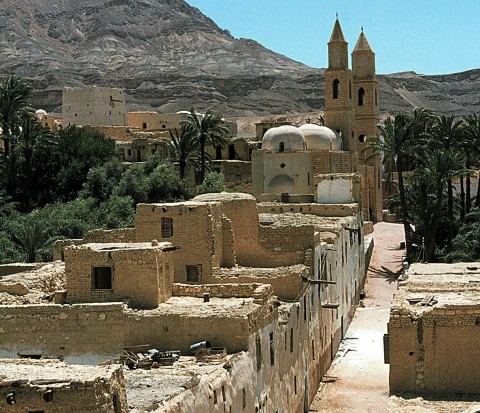Copts
The word 'Copt' is derived from the Greek aiguptios (Egyptian) which, in turn, goes back to the old Egyptian name for Memphis, hut-ka-ptah. The Arabs corrupted the Greek to qibti, which was ultimately turned into 'Copt'.
Romans and Christians
After the last queen of Egypt Cleopatra was defeated Egypt was incorporated into the Roman empire. According to tradition, the evangelist Mark brought Christianity to Egypt in about A.D. 50. The new religion linked up closely with basic old Egyptian beliefs about the hereafter During the second and third centuries the majority of the Egyptians accepted Christianity. As they refused to venerate the Roman gods they were regularly persecuted. Emperor Diocletian (284-293) was particularly cruel towards them. The first year of his reign has been dubbed 'the year of the martyrs' and marks the start of the Coptic era. The acceptance of Christianity by emperor Constantine (312-337) put an end to the persecution of Christians.
Doctrinal conflict
At the Council of Chalcedon, in 452, the Egyptian church separated from Rome and Constantinople. The Egyptian Christians, who were already isolated by the desert, now lost most contact with the outside world. Their isolation only increased in 640-641 when the Arabs conquered Egypt. The Christians withdrew to villages in the desert, where for a long time their language and customs hardly changed. Sometimes the followers of a hermit who was thought to be exceptionally pious settled in his vicinity. Religious communities began to form. Pachomius (292-346) is considered the founder of monasticism because he was the first to frame rules for these early communities (fig. 54).
Coptic art
In Coptic art the ancient Egyptian, Graeco-Roman and Christian traditions continue independently beside each other while also being interwoven . Sometimes it is unclear whether a motif (APM03804) has a pagan or a Christian meaning. Some motifs remain unchanged over centuries. In other instances pagan elements are replaced by Christian symbols or given Christian significance.
Coptic textiles
The Christians stopped mummifying the dead and began simply to bury them in the desert sand. Because of the extremely dry conditions, the bodies and garments have often been well conserved. Much is therefore known about Coptic textile. The Egyptians wove linen for their clothing. Linen fibre is strong and can be worked into a very thin fabric. But since it cannot easily be dyed it was usually left in its natural yellowish white colour. The Greeks, on the other hand, often wove in wool, which is weaker than linen, with thicker strands, and which can readily be dyed. Coptic weaving combines the two traditions. The actual garment was, as a rule, made of linen, while the decoration (APM 6089). in fixed places on the garment was woven in wool. The placement of the ornaments goes partly back to Roman usage; they include shoulder sections and long bands which run down from the shoulders.
